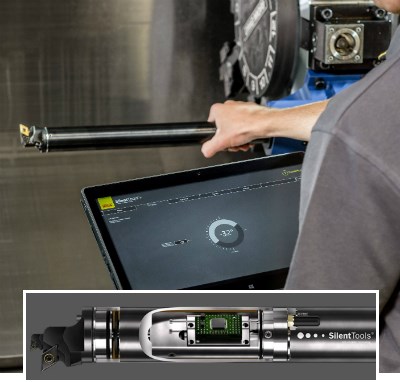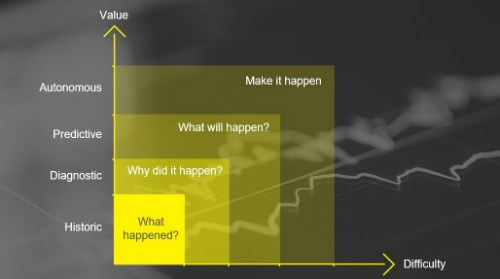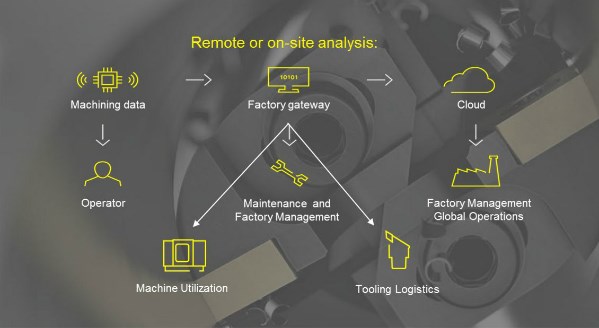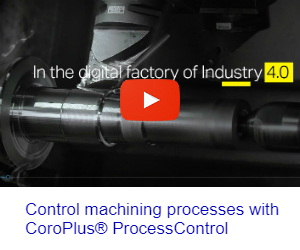Steps to Successful Machine Shop Digitalization: Think Big
Sponsored ContentSandvik’s three-part series on data-driven manufacturing is a great entry-point for machine shop managers trying to figure out what Industry 4.0 might mean to them. Here are the highlights.
Share
By Jeff Rizzie, Director of Digital Machining at Sandvik Coromant

Industry 4.0. Industrial Internet of Things (IIoT). Smart manufacturing. The buzzwords abound, but what does this technology really mean for your shop?
“Whether your business is small or large, you should know that digital manufacturing is coming, and it's coming really quickly,” says Sean Holt, president of Sandvik Coromant for the Americas. “You have to assess how it’s going to affect the sustainability of your business, what are its risks, its benefits, and most importantly, how to take the first steps towards digitalization.”
Download the three-part series.
“Who cares?” you might be thinking. “I just want to make good parts, on-time, and for a fair price. That’s what’s most important to me.”
Consider this: any seasoned machinist or programmer can walk up to a machine and know instantly if something is awry. There’s just one problem: finding those qualified people is increasingly arduous, and most shops need their operators to manage multiple machines. It would be a huge advantage to have another way to know that the parts being made on Machine #5 right now are about to go out of tolerance, and further, that the spindle bearings on VMC #2 will fail in three weeks.
The path to those capabilities is data; cutting tool data, machine data, quality data, operator productivity data. It may sound simplistic, but that’s the essence of Industry 4.0 and the Internet of Things: the collection and analysis of data, followed by better decision-making as a result of these data-related efforts. To the shop of the future, data will be everything.
That’s why many equipment builders, and now tooling suppliers, are making their products “smart,” giving manufacturers the ability to “listen” to what the shop floor is telling them with data that is easy to understand.
The CoroPlus® ProcessControl monitoring system is a good example of digital technology that increases the overall in-cut process stability and security. Here’s how it works.
In a controlled machining process where decisions and actions are based on real-time information and facts, manufacturers are able to optimize their processes and significantly reduce their manufacturing-related waste. CoroPlus® ProcessControl monitoring system—including hardware, software, installation and support—increases the overall in-cut process stability and security, ultimately enabling increased productivity and profitability.
Shops that embrace digitalization will have much better information with which to operate their businesses because:
- Their machines and cutting tools will be able to identify chatter (even when it can’t be heard), and part quality, and tool life will be better.
- Understanding what’s going on inside spindle bearings, axis motors and other machine components will prevent unexpected equipment failures.
- Knowing exactly how hard to push cutting tools will increase production levels.
- The ability to more easily spot trends in part quality and tool wear will help machinists and engineers develop better processes.
Start Small

Sankvik's SilentToolsTM Plus provides real-time feedback on tool vibration.
Getting started is easier and less expensive than you probably expect—you won’t need a big budget ($1,000 or so should do), or the technical skills of a computer scientist. “I tell people to start small,” says Andy Henderson, vice-president of engineering at industrial technology firm company Praemo. “Hook up one machine, start collecting some data, and then let the value you're receiving from that machine pay for the next one, and the next, scaling upwards as you go.”
At the very least, getting your machine tools “connected” will let you check production status from anywhere. Taken to the next level, you can gather hundreds or even thousands of data points from a modern machine tool, including in-process metrology data, machine maintenance information, production output, scrap levels, cutting tool usage, job status...the list goes on and on.
But don’t do that. At least, not yet. Better to pick a pilot machine, choose one or two of whichever production values or machine metrics are most important to you, and start watching the data flow in. You’ll soon spot causes of downtime that are expensive to the shop but simple to cure. Areas for continuous improvement will become abundantly clear. Unexpected failures will eventually become a thing of the past.

Additional benefits accrue as shops move up the scale of digitalization. Simply finding out why your equipment isn’t running is a good start. Ultimately, it lets shops focus sharply on the best value-adding activities reaping the highest returns on equipment and people.
Worried about the cost? Don’t be. According to Will Sobel, co-founder and chief strategy officer of advanced manufacturing analytics software company VIMANA, the ROI can be “amazingly ridiculous,” sometimes as short as a few weeks. “If you look at a typical manufacturing processes in a typical shop, equipment utilization is often around 30-percent,” he points out. “It doesn't take much to improve that figure.”
Move Rapidly
Stas Mylek, Mastercam developer, CNC Software’s director of product management, says those looking for a quick win should consider purchasing monitoring software. “There are plenty of applications out there that you can get for minimal investment and that make the traditional green, yellow, and red indicator lights obsolete,” he says. “Using such an application to collate and make sense of data allows you to better understand your processes and where each machine is making money.”

A connected shop provides actionable intelligence to all levels of the enterprise on
how to manufacture more efficiently.
Having good monitoring software is one thing; acting on that information is another. And shops will be well served by appointing a data evangelist (or team, depending on the size of the company) to chase down improvement opportunities. This person will work with suppliers, report back to management, and work to spread the good word of digitalization throughout the organization.
“There goes the budget,” you may say. And while it’s true that taking your IIoT data collection pilot project to the next level will cost the company some cash—in infrastructure, hardware and software, and additional labor costs—it’s important to remember that the additional visibility to production and machine tool data, and the benefits derived from both, will greatly outweigh any investment costs.
That’s not to say that the appointed data evangelist should pound people on the head with his or her findings. For one thing, this person will typically have less manufacturing skill and experience than the machinists, programmers, and engineers responsible for part production each day—a talented but technically-oriented machine operator is a good choice for such a role, one able to communicate effectively while recognizing that the people he or she is working with may be reluctant to change their ways.
And there is still a vital role for your experienced people to play. Software doesn't make great choices when comparing different solutions. That’s why humans will always be better (for the foreseeable future, at least) about when to shut a machine down, for example, or the best way to adjust feeds and speeds when chatter occurs. This is why involvement from the entire manufacturing team is crucial to any Industry 4.0 implementation.
Ready to pull the trigger? All it takes is a connected machine tool, a little data and willingness to change. Properly implemented, the results will be greater throughput and higher profit margins. Get going. Industry 4.0 is waiting.
Jeff Rizzie, is director of digital machining at Sandvik Coromant. Contact him at jeff.rizzie@sandvik.com


